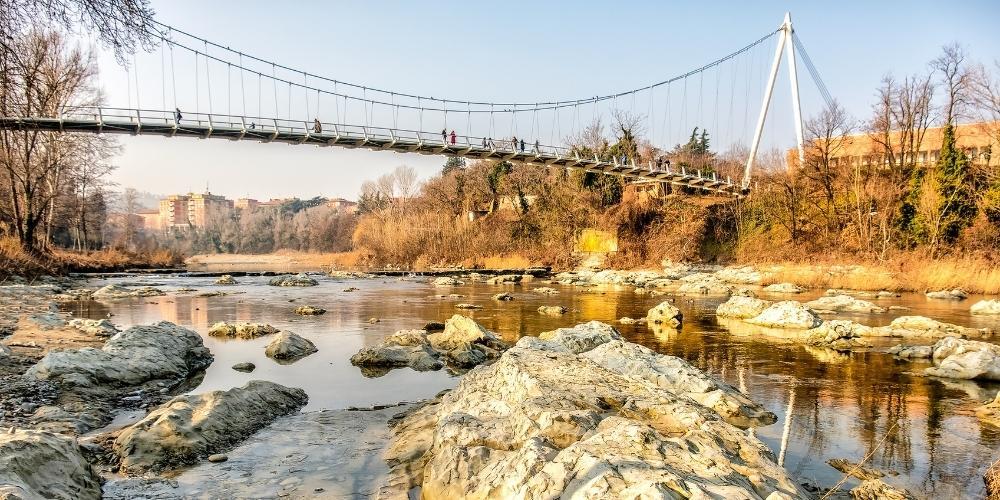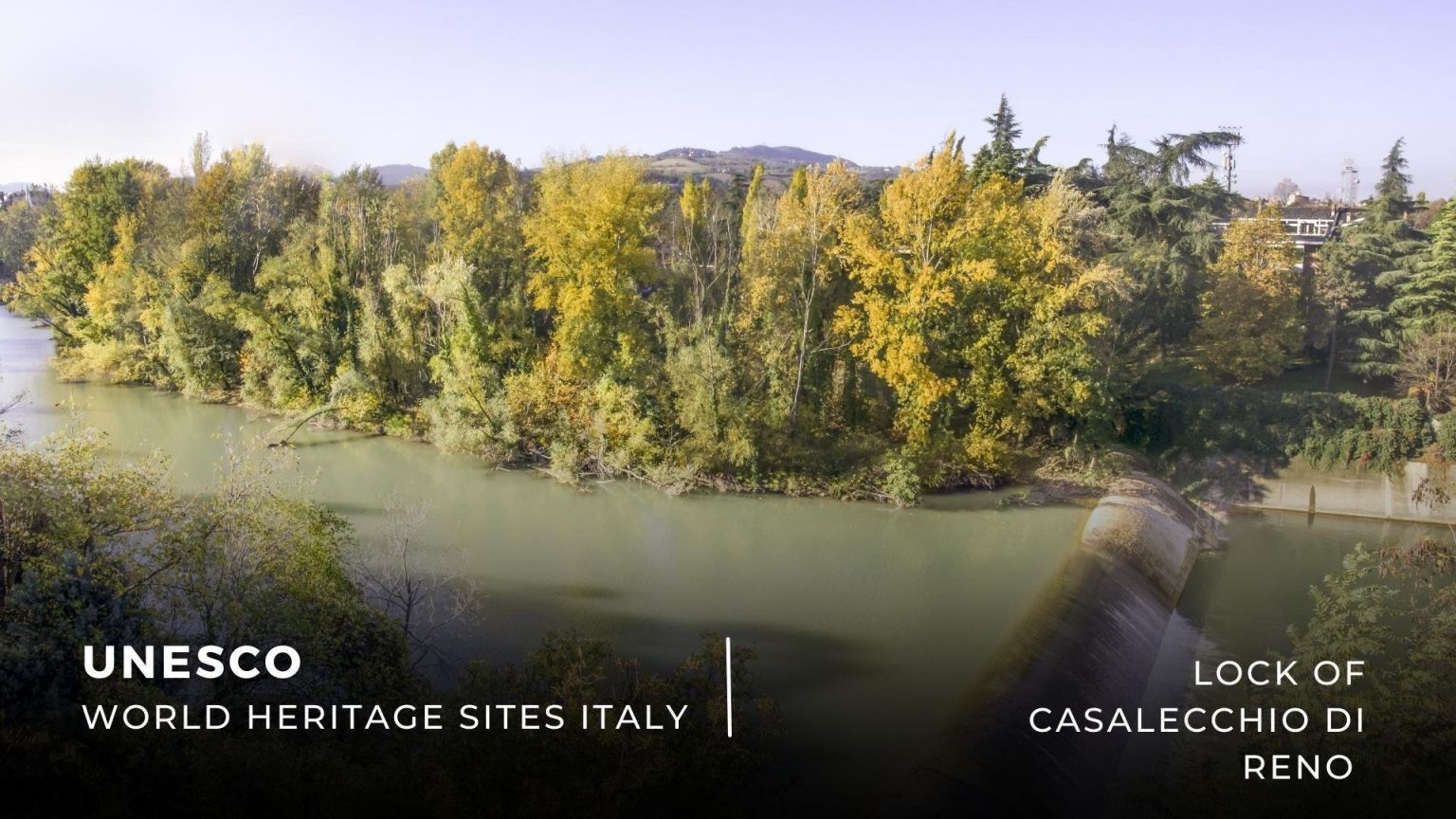It's difficult to remain indifferent before the glorious solemnity of this ancient artefact, a unique example of 'water archaeology'. A history and legacy that goes beyond the merely functional aspect of a building as fascinating as efficient.
Here is what you need to know about the Lock of Casalecchio di Reno and why UNESCO has chosen it as a Messenger of a Culture of Peace.
Oh, and we also suggest some activities in the surroundings that you might find interesting!

The Lock of Casalecchio di Reno, a Unesco symbol of peace
It's the oldest hydraulic work in Europe still in operation. The Casalecchio di Reno Lock, an artificial barrage placed along the Reno River, is a mammoth monument that combines the ingenuity and age-old effectiveness of the project with a substantial symbolic value.
Being 160 metres long and about 35 metres wide, la Chiusa is located 83 kilometres from the source of Monte delle Piastre.
Together with the Lock of San Ruffillo, it represents the 'pillar' of Bologna's water network, a sophisticated system of canals developed between the 12th and 17th centuries.
The opera, among the most avant-garde in the Old Continent at the time, was fundamental both for the development of transport and power of the windmills used in the silk textile industry.
Dating back to 1208, the Casalecchio Lock immediately represented an excellent means of exploiting the Reno River waters along the Emilia-Romagna plain's territories. Thanks to this unique hydraulic system, Bologna became a first-rate industrial and economic centre at a time when free cities embarked on increasingly pressing and ambitious expansionist ventures.
The waters of the river, channelled along the Reno Canal, were exploited for the most varied commercial enterprises—paper and hemp mills, fish farms, and tanneries made use of them.
Both the Lock and the Reno Canal still play a key role as they feed the Cavaticcio and Canonica hydroelectric power stations. A 'detail' that certainly leaves one astonished, considering that the work — with its mighty walls, floodgates and regulating spillways — has been in continuous operation for 800 years.
Centuries during which la Chiusa has undergone a series of alterations and reconstructions. The current look dates back to 1567 when Pope Pius V entrusted the renovation to Giacomo Barozzi da Vignola, the emblematic architect of the late Renaissance.
Why the Lock of Casalecchio di Reno is a UNESCO World Heritage Site
The Lock of Casalecchio di Reno was named a Messenger of a Culture of Peace in 2010. This UNESCO programme was launched in 2000 and aimed to collect monuments and natural sites accredited as symbols of peace. All in the most authentic spirit of the organisation, which has always promoted culture as a means of union and brotherhood.
An ancient waterwork of considerable scenic impact, the Casalecchio Lock's worth goes beyond its undeniable and extraordinary historical value. To be romantic, that's the aspect that best describes its scope.
Needless to say, the common thread is water, which la Chiusa tame and channel. Water, a universal right, has united the Bolognese community as much in the 13th century as today.
The birth of the Lock and the system of canals and water supply corresponded to the development of the community of the time, accompanied by gradual economic, social, and demographic growth. This significant change was moved by water, which, more or less directly, influenced the quality of life and unity within the population.
Therefore, it's no coincidence that the prestigious recognition by UNESCO came in the year in which the UN General Assembly recognised access to drinking water as a fundamental human right.
Exploring the surroundings: places and tasty appointments
Amidst the plains and hills of the Emilian Apennines, Casalecchio di Reno is surrounded by the typical gentle and luxuriant nature of Emilia Romagna, a generous region in all respects: attractions to visit, gastronomy and hospitality.
Colle della Guardia guards the town with the tall and severe silhouette of the Sanctuary of San Luca, a mesmerizing panoramic point in Bologna. You can reach it in about two hours by following the Brégoli Path, an easy itinerary within everyone's reach. You choose whether to undertake it in a sporting spirit or with a pilgrim attitude.
The trail passes through Parco della Chiusa, which stretches across 110 hectares of meadows and forests. Also known as Talon Park, it's a densely green area rich in fauna where you'll find numerous cycling and walking routes. The park is included in the itineraries of the two paths that connect Tuscany to Bologna, La Via degli Dei and La Via della Lana e della Seta.
Lido di Casalecchio is the right place to enjoy a more suggestive perspective than ever on the Lock—the Reno is shallow and free of currents at this stretch.
Among the events to mark in your diary (do it, especially if you are a good eater), we recommend La Festa dei Sapori Curiosi, an annual culinary event that celebrates the typical cuisine of Casalecchio with tastings and shows, and La Festa del Gelato Artigianale (Artisan Ice Cream Festival).
Also very popular is the patron saint's festival of San Martino in mid-November, with markets and the typical lantern parade.
Let's discover the town: the 'little Paris' of yesteryear

To visit the extensive waterworks we are telling you about in this article, you must head to Casalecchio di Reno, about 6 kilometres from Bologna. The town can be easily reached by train or bus.
The municipality conceals a fascinating past and is among the most populous in the metropolitan city. It rises in a place where the first settlements date back to the Neolithic period. In conjunction with the construction of the Lock and bridge over the Reno, the area took on the shape of a real town, with castles and fortresses, during the Middle Age.
At the turn of the 19th and 20th centuries, Casalecchio, elected as the favourite holiday destination of the Bolognesi, was known as 'little Paris', embellished as it was by refined architecture and streets packed with tourists. A magic that ended abruptly following the heavy bombing that almost razed it to the ground during World War II.
About the author
Written on 12/01/2023



Lorena Calise
Discover the Lock of Casalecchio di Reno, a monumental UNESCO symbol of peace a short distance from Bologna.